The reasons swine flu could return
Share using Email
Share on Twitter
Share on FacebookShare on Linkedin
(Image credit: Getty Images)
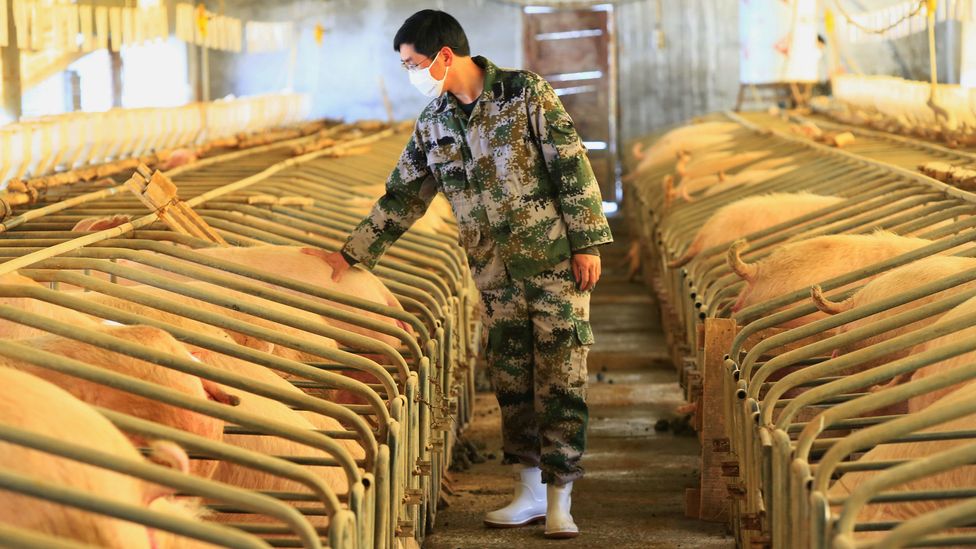
By Harriet Constable2nd February 2021
The last global flu pandemic was declared over in 2010, but the virus responsible is still with us today – and scientists fear human activity is increasing the risk of new influenza A outbreaks.
Article continues below
ADVERTISEMENT
I
Imagine the scene: a radio crackles into life. A British accent can be heard on the BBC World Service, making an announcement. According to the World Health Organization (WHO), global deaths from the disease have increased by more than 700 this week to 5,700 people, the broadcaster says. In Europe, Ukraine is closing schools and cinemas while banning public gatherings. In Britain, cases are doubling every week. In the US, the president is declaring a national emergency.
It sounds like an all too familiar broadcast today, but these events took place in October 2009, when the world experienced its last pandemic – swine flu.
The H1N1 virus is believed to have begun its deadly journey in pigs from a small region of central Mexico in January 2009. By March, the first cases were reported in California and Texas. By June, it was in 74 countries across the globe. A year later, when the WHO declared an end to the pandemic, between 151,700 and 575,400 people had died.
A massive global vaccine effort led by the US helped end the pandemic, but the H1N1 virus is still with us. Every year it circulates as a seasonal flu, causing sickness, hospitalisation and deaths.
Story continues below

Many countries shut theatres and restricted public gatherings as the swine flu pandemic in 2009 spread around the world (Credit: Anshuman Poyrekar/ Getty Images)
To better understand what we're up against, a massive collaboration has been taking place across 2,500 European pig farms, sampling more than 18,000 individual pigs. The scientists involved found that influenza A viruses – those which can become human pandemic viruses – were present on more than 50% of the farms they visited, particularly in areas of intense pork production including Denmark, Brittany, northwest Germany and the Netherlands.
In other words, they found a pandemic waiting to happen.
The building blocks of a pandemic
On the northeastern cusp of Germany, where the land meets the Baltic Sea, lies the tiny Isle of Riems. Access is via a causeway, and not by accident. The Isle of Riems is home to the world’s oldest virus research institution, founded in 1910 by scientist Friedrich Loeffler. Modern biosecurity measures mean that virus institutes can be based almost anywhere, but in 1910, after too many diseases were finding their way from his laboratory into the local community, Loeffler decided it was best to set up on an island. Nowadays the Friedrich Loeffler Institute (FLI) is Germany’s leading animal disease centre.
It takes 30 minutes or so to circumnavigate the island on foot, passing large square buildings housing the laboratories, animal experiment facilities and animal enclosures, which are home to pigs, chickens, cattle and a wild boar breeding zone. At the furthest tip of the lot lies the duck enclosure, where teams monitor bird flu patterns and newly emerging virus strains, by attracting wild birds to stop in on their migratory journeys. Thousands of cranes, wild ducks and geese pass through this area each year.
So far, they have found four influenza viruses circulating which already have some of what they call the "building blocks" of a pandemic. They are viruses that can infect humans, have the potential to spread from human to human, and for which there is no vaccination or innate immunity. Currently, none of the viruses discovered have all the necessary building blocks. But if any one of these viruses manages to adapt, the chance of another pandemic is substantial.
The team also found that the prevalence of these viruses in pigs is increasing over time.
"Our first surprise in this surveillance programme is that… about 30% of pigs were positive for influenza A virus. This is a lot," Beer says. Pigs, like humans, are susceptible to more viruses when they are young because they have not yet had time to build up the antibodies needed to fight them. In Europe's intense pork production system, pigs live to be just six months old before they are killed. That's not yet old enough to fight off most influenza viruses, so "you have a lot of highly susceptible pigs", says Beer. More than 257 million a year, in fact.
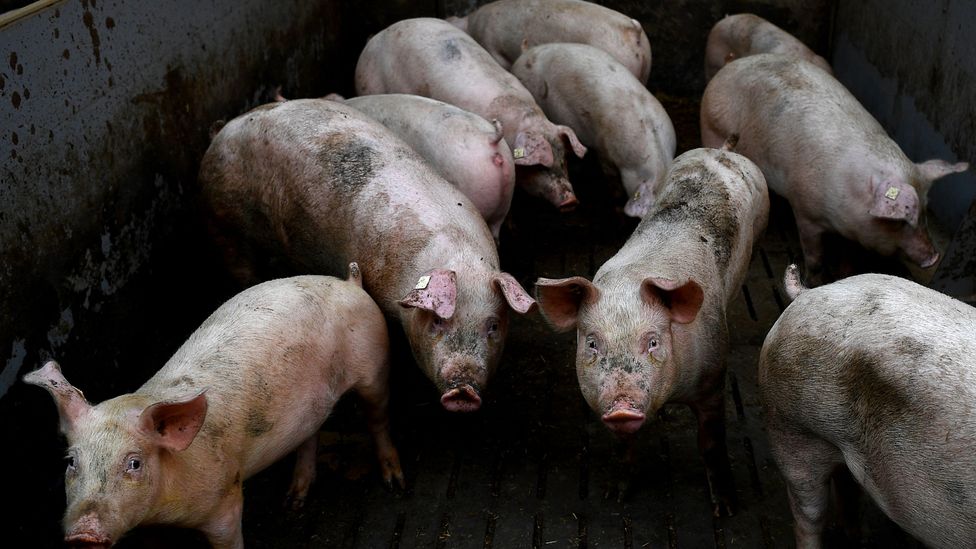
The scale of modern pig farms is concerning scientists as it allows infectious diseases to take hold more easily (Credit: Damien Meyer/Getty Images)
But Europe has advantages that make it less prone to human disease than some parts of the world. It's a wealthy continent with good healthcare systems in many of its countries, it's home to some of the world's leading scientists, and it generally has a temperate climate.
These don't make the region immune to a pandemic, as we're woefully aware.
Traditionally, humans developed farming systems suitable for our environments. But that has changed. With the surge in population has come a surge in demand for protein sources. Europe is trying to produce more pork, faster than ever, and that demand is creating new diseases.
Beer's colleague Timm Harder is head of the Animal Influenza Reference Laboratory at the FLI and a co-author of the surveillance report. He says there's a connection between the way Europe is producing protein and the viruses they're seeing.
"In 1995, a pig holding that had 200 sows was an exception. Now we have holdings with 2000 and 20,000 sows. It's a gross increase in the farm size. This is something that changes the epidemiology of the influenza viruses," he says.
With their intense and increasing farming of pigs, humans are helping to change the way influenza viruses operate and keep them active for longer. "It's a very nice playground for viruses," says Harder.
A petri dish for disease
The good news is that, if you're fit and healthy, catching H1N1 now will likely result in mild flu symptoms that pass in a couple of weeks.
The bad news is that influenza viruses can jump between species and mix and mingle with other influenza strands. It's these new concoctions that scientists worry about: they have the ability to cause the significant health issues, death and worldwide disruption that we're seeing with Covid-19.
And pigs, it turns out, are an ideal mixing vessel for those new strains.
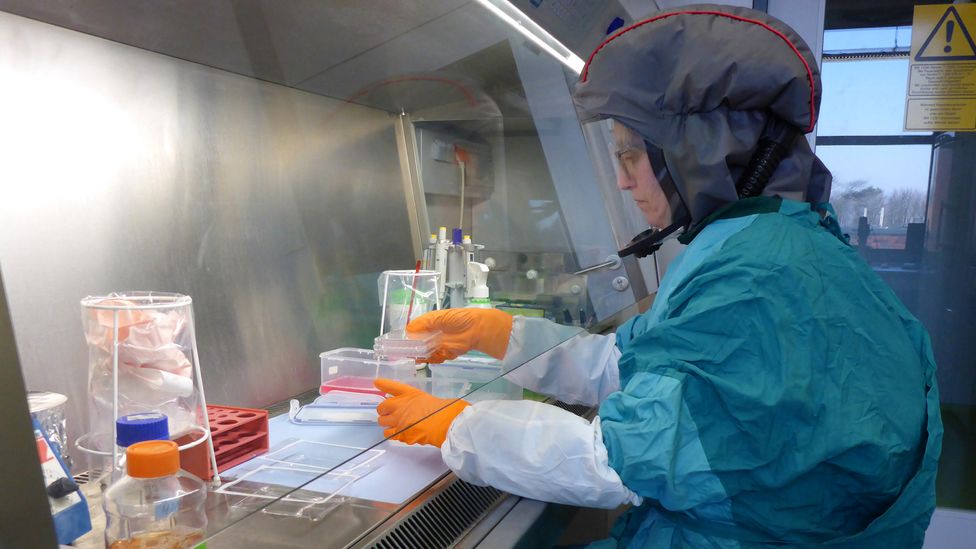
Researchers at the Friedrich Loeffler Institute regularly take samples from pigs around Europe to test for influenza (Credit: Friedrich Loeffler Institute)
"We know that pigs are not usually the originators of the virus, but that they act as a petri-dish, mixing up influenzas from humans, birds and perhaps other species and then creating more lethal concoctions that can spread back to other species," says Nicola Lewis, a collaborator on the Europe sampling project and an evolutionary biology professor at the UK's Royal Veterinary College.
In fact, she says, the biggest reason for having so many strains of flu among European pigs is that humans infect pigs with our own seasonal flu each year. This is why pig farmers are advised to get their annual flu shot. But this is not just an issue affecting European pigs – across the globe, humans and pigs are sharing and mixing viruses.
With hundreds of thousands of hosts to choose from, these viruses can jump and adapt all the time. This rapidly-changing nature of the influenza viruses makes the work of people like Beer, Harder and Lewis incredibly complicated; they're working with a constantly moving target.
Not only do pigs blend up viruses from other species like humans and birds, they mix and mingle the viruses from one another. Pigs in Europe have different strains of influenza than pigs in Asia, for example, and when these two breeds meet they can infect one another to create new diseases.
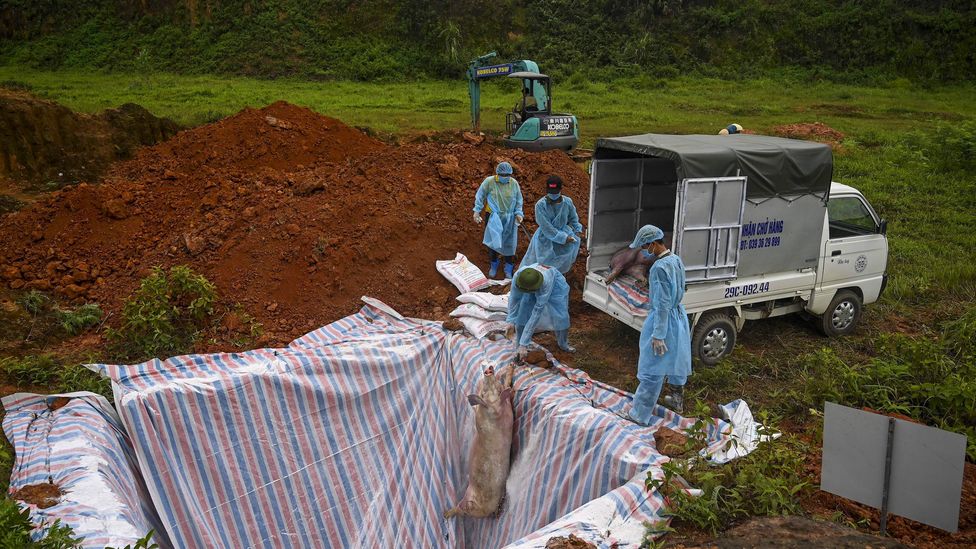
Another disease has been spreading around the world and wreaking havoc on the pig industry – African Swine Fever (Credit: Manan Vatsyayana/Getty Images)
In 2009, it is believed long-distance trade of pigs between Mexico, the US and Europe allowed a new strain of influenza to form, infecting young people in the region who didn't have antibodies before rapidly spreading across the globe. "Animal trading plays [a crucial role] in bringing together diverse viruses from different continents, which can then combine and generate new pandemic viruses," write the authors of a 2016 report on the origins of the 2009 pandemic.
Within the European continent, pigs are not moved around a lot. But in North America, pigs are moved regularly: they might be born in North Carolina, and killed in an abattoir in the Midwest because it's near the cereal farm they feed the pigs on.
"Some influenzas are evolving at twice the rate in North America because of this [movement]," says Lewis.
(Watch our video below to learn about how human activity is increasing the risk of pandemics in the future.)
Who's to blame for the next pandemic
China is another example. The country regularly imports pigs from other parts of the world for breeding or to repopulate pig stocks that have been wiped out by disease. In doing so, they could be importing new viruses their pigs have not yet encountered, viruses that can harm humans.
This is particularly concerning when you learn that record numbers of pigs globally are currently being killed by a disease called African Swine Fever (ASF).
A pandemic within a pandemic
In September 2020, Egbert Gleich, who works for the Department of Forestry had just received the bad news that ASF had wandered across the border from Poland and was now in Germany's Brandenburg Forest – an area of 1.1 million hectares filled with densely packed pine trees, red foxes and, crucially, wild boar. He believes the boar transported the disease here.
It's a huge task: ASF is a highly contagious virus that can survive for months in an infected host. Thankfully, ASF doesn't infect humans. But its impact on pigs has been substantial. In 2019, it was reported that the disease has already killed a quarter of the world's pigs, including half of China's swine population. In 2019, China was massively increasing its pig imports from Brazil and Europe to fill the huge meat supply shortfall caused by the ASF deaths.
ASF also illustrates the connectedness between the actions humans take and the diseases we, or animals, suffer.
As human activity warms up the planet, wild boar populations have thrived. Years ago, a cold winter would have frozen the ground, restricting access to the roots, bulbs, nuts and seeds boar usually feed on and killed off a big chunk of the population. Now, the winters are milder, and the wild boar don't die off: they move closer to cities where they've learned there's ample food and shelter. "It's a smart species with a high reproductive rate, and we give them all that they need," says Sandra Blome, who runs the national reference laboratory for ASF at the FLI on Riems.
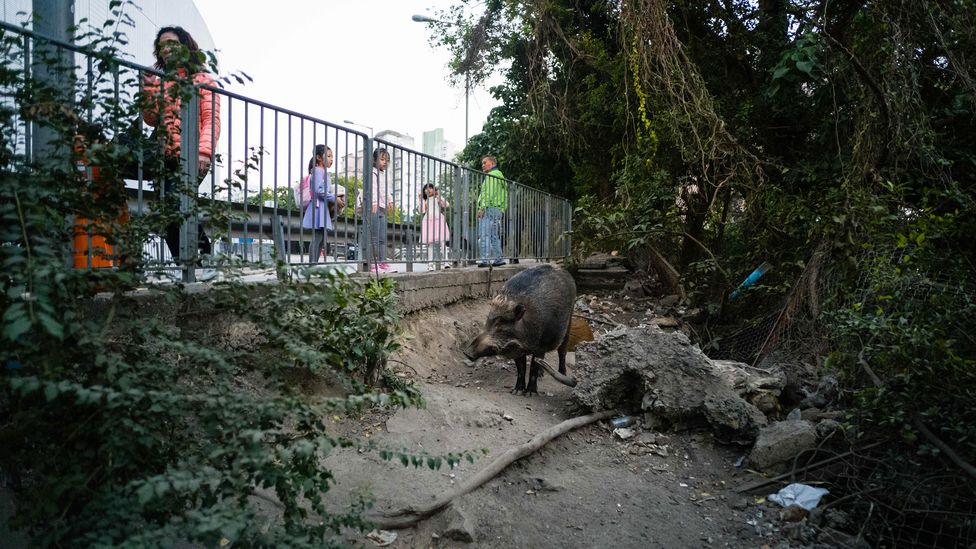
Wild boar have flourished in cities thanks to the ample food and shelter they can find there (Credit: Anthony Wallace/Getty Images)
As a result, there are now millions of wild boar across Europe, each with the same petri-dish ability to mix potent viruses and spit them back out into other species. Many now have ASF, and as they move around the continent and come into contact with industrial pigs, they infect herds. The domestic pigs die, populations need to be restocked, new viruses are moved and shared, and humans are one step closer to the next pandemic.
But when it comes to the ways humans are making a spillover more likely, that's just the tip of the iceberg. In Asia, for example, pig farms are even more intensely populated than in Europe, and the disease is spread by the controversial (and in many countries, illegal) practise of feeding pigs the blood and remains of other dead pigs. These are often, unbeknownst to the farmer, infected with ASF. "This is like an infection experiment," says Beer.
Meanwhile, ASF exists in Europe in the first place because of human activity. Once a virus that only plagued warthogs in East Africa, it was brought to the European continent most likely by ships from colonised Angola travelling to Portugal in 1957. It was again introduced by humans to Georgia in 2007 via contaminated meat which was consumed by wild boar. From there the disease spread all over Russia and eastern Europe, with infected boar and infected carcasses being found as far away as Belgium.
How ASF spread across the globe
Because humans are unaffected by ASF, you wouldn't know if you were eating a pork burger infected with it. But sling the leftovers in a dumpster for a wild boar to sniff out and two days later that boar will probably be dead – after it's infected a few of its closest friends and family.
One part of the solution might seem to be to cull wild boar in Europe. But poor hunting practises can actually help spread the disease, with hunters and their dogs coming into contact with wild boar blood and then transporting it elsewhere. "It's not so easy to say 'Let's just eradicate the boar and then we don't have a problem'," says Blome, who is a hunter herself. She points out that wild boar also play an important part in the ecosystem, breaking up the soil which helps young trees to find room to grow, eating carcasses of other animals and proving a food source for predators.
The solution, says Blome, is to have a toolbox of methods for dealing with the disease, from early detection to vaccinations. At the FLI, she and her team run a wild boar breeding unit, testing out new vaccination candidates and trying to understand what differences, if any, boar and pigs have when it comes to their ability to fight disease.
In the forest where ASF entered Germany, an array of high-tech equipment, including drones, helicopters and infrared detection, is being used to try to find carcasses and remove them from the environment. In late October, Blome said they had already found more than 90 carcasses in just over a month.
Blome and her colleagues are now collaborating with scientists working in the Bavarian National Forest to understand more about the disease. Every three weeks since July, Marco Heurich and his team have shot three healthy wild boar and placed the carcasses in the forest. They take photos and videos to monitor the decomposition process.
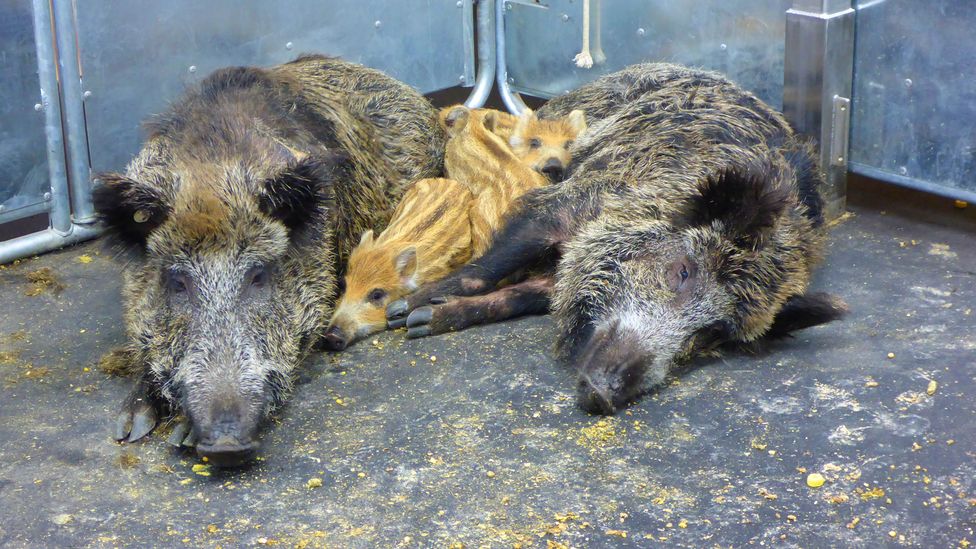
African Swine Fever does not affect humans but it is a devastating infection for pigs and wild boar (Credit: Friedrich Loeffler Institute)
"We're trying to determine four basic questions," he says. First, how long ASF can survive in a carcass. Second, whether the virus can survive in the soil and for how long. Third, in what time span the animals are still warm enough to distinguish from their surroundings with a drone. And fourth, whether there any scavenging species which carry dead parts of the animal away, in doing so spreading the disease further afield. These details would give scientists a better chance of stopping the disease.
Despite all this work on wild boar, "the most important mechanism of spread are humans", Heurich says. ASF "is very infectious – most of the animals die, and they die quickly. Humans, however, spread it and make the spread fast."
State of surveillance
Trying to keep track of these diseases as they adapt and spread is complicated at the best of times, but there are other challenges too.
Despite the havoc swine flu has wreaked on human health in the past, it is not a "notifiable" disease. In other words, farmers are not required to submit swab samples of their pigs for testing. All of the 18,000 pig samples Harder and Beer took for their Europe surveillance work were collected voluntarily.
This is different to, say, bird flu – a notifiable disease where farmers are legally required to report any suspected disease to the government.
Beer believes it's time for Europe to introduce a mandatory surveillance programme. "We need continuous surveillance, looking at the development of the different strains, to [help us] make some predictions," he says.
The sampling and surveillance work Beer and his colleagues have completed so far have allowed them to create an important collection of novel swine flu viruses, detailing their biological properties and genetics. They then use EpiFlu, an international influenza database with more than a million sequences, to compare their viruses. "It gives you an idea of what the most related viruses are and where the virus's genetic components come from," says Beer.
With this information, Beer and his team can more rapidly understand viruses and start selecting those which show pre-pandemic potential to create prototype vaccines – antidotes ready to be produced at scale should a disease jump from pigs to humans.
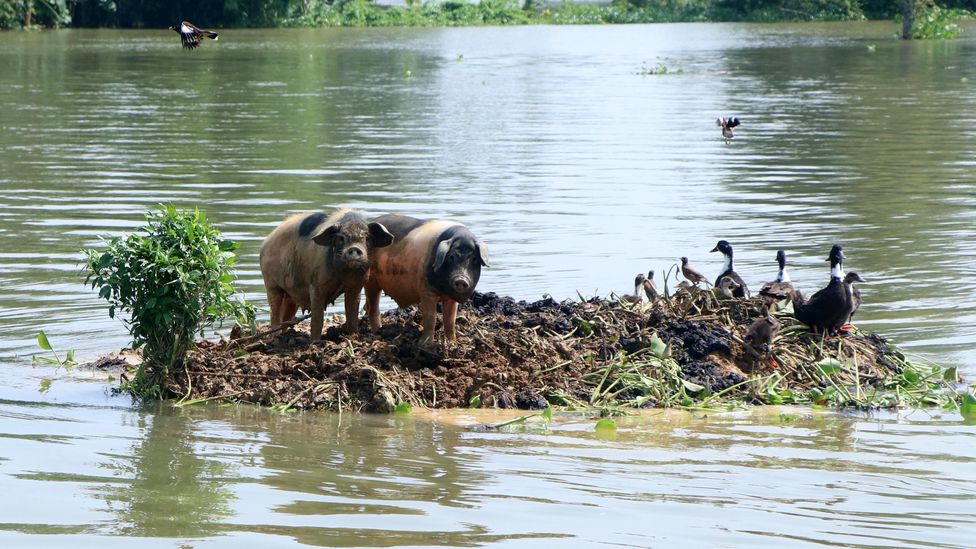
While bird flu is a notifiable disease that farmers have to report to authorities, swine flu is not (Credit: Kulendu Kalita/Getty Images)
It may not be enough to prevent the next pandemic, Beer says. But it could certainly help us create and disseminate a vaccine much more rapidly than is currently possible. We can be "better prepared, we can improve our reaction time… and we can influence the impact of a pandemic", Beer says.
Still, this work takes time and funding to complete – two resources that can be far from abundant.
Changing the way we raise pigs and interact with livestock could be another important intervention. In October 2020, the advisory board of Eat, a nonprofit pushing for food system transformation, released an open letter to the G20, arguing that the expansion of factory farming and unsustainable agriculture is increasing the risk of virus spill-overs from animals to people. "All the evidence we have today shows that if we want to achieve a resilient recovery from the Covid-19 crisis, avoid future pandemics and stand a chance of delivering on the Sustainable Development Goals and the Paris Agreement, we must focus on food," the letter states.
There has been a broader push to move away from factory farming to having smaller groups of pigs raised in greener environments, as well as a shift toward more healthy, sustainable agriculture, too. These ideas form a key part of the European Green Deal's Farm to Fork strategy. Internationally, organisations like Farm Forward are providing funding to communities in developing nations where industrial animal farming is on the rise to maintain their independence and protect their rural farms, which are deemed to be more pandemic and environment-friendly.
These changes can take time. Meanwhile, I ask Lewis what keeps her up at night. "I'm very concerned about all the viruses in pigs globally," she says. "We need way more information about what's out there."
The more we know about a disease, the better placed are to avoid its spread. But ours is a complex, connected system. We don't live in silos – we can't detach Europe's diseases from Asia, or Mexico's from the United States, and keeping on top of every virus is nearly impossible. "We just catch up, and it changes," says Lewis.
For all the work going on in the scientific community to stop spillover, far bigger changes – from social, to regulatory, to environmental – could be needed to avoid the next pandemic.
Share using Email
Share on Twitter
Share on FacebookShare on Linkedin
(Image credit: Getty Images)

By Harriet Constable2nd February 2021
The last global flu pandemic was declared over in 2010, but the virus responsible is still with us today – and scientists fear human activity is increasing the risk of new influenza A outbreaks.
Article continues below
ADVERTISEMENT
I
Imagine the scene: a radio crackles into life. A British accent can be heard on the BBC World Service, making an announcement. According to the World Health Organization (WHO), global deaths from the disease have increased by more than 700 this week to 5,700 people, the broadcaster says. In Europe, Ukraine is closing schools and cinemas while banning public gatherings. In Britain, cases are doubling every week. In the US, the president is declaring a national emergency.
It sounds like an all too familiar broadcast today, but these events took place in October 2009, when the world experienced its last pandemic – swine flu.
The H1N1 virus is believed to have begun its deadly journey in pigs from a small region of central Mexico in January 2009. By March, the first cases were reported in California and Texas. By June, it was in 74 countries across the globe. A year later, when the WHO declared an end to the pandemic, between 151,700 and 575,400 people had died.
A massive global vaccine effort led by the US helped end the pandemic, but the H1N1 virus is still with us. Every year it circulates as a seasonal flu, causing sickness, hospitalisation and deaths.
- This story is the part of Stopping the Next One – our multimedia series looking at which diseases are most likely to cause the next global pandemic, and at the scientists racing to keep that from happening. Find out more about the series, and read the other stories, here.
- Watch the series of videos that accompany this series on BBC Reel.
Story continues below

Many countries shut theatres and restricted public gatherings as the swine flu pandemic in 2009 spread around the world (Credit: Anshuman Poyrekar/ Getty Images)
To better understand what we're up against, a massive collaboration has been taking place across 2,500 European pig farms, sampling more than 18,000 individual pigs. The scientists involved found that influenza A viruses – those which can become human pandemic viruses – were present on more than 50% of the farms they visited, particularly in areas of intense pork production including Denmark, Brittany, northwest Germany and the Netherlands.
In other words, they found a pandemic waiting to happen.
The building blocks of a pandemic
On the northeastern cusp of Germany, where the land meets the Baltic Sea, lies the tiny Isle of Riems. Access is via a causeway, and not by accident. The Isle of Riems is home to the world’s oldest virus research institution, founded in 1910 by scientist Friedrich Loeffler. Modern biosecurity measures mean that virus institutes can be based almost anywhere, but in 1910, after too many diseases were finding their way from his laboratory into the local community, Loeffler decided it was best to set up on an island. Nowadays the Friedrich Loeffler Institute (FLI) is Germany’s leading animal disease centre.
It takes 30 minutes or so to circumnavigate the island on foot, passing large square buildings housing the laboratories, animal experiment facilities and animal enclosures, which are home to pigs, chickens, cattle and a wild boar breeding zone. At the furthest tip of the lot lies the duck enclosure, where teams monitor bird flu patterns and newly emerging virus strains, by attracting wild birds to stop in on their migratory journeys. Thousands of cranes, wild ducks and geese pass through this area each year.
Martin Beer has worked here for 20 years. He is one of the scientists who began rapidly creating and testing vaccinations when the 2009 swine flu pandemic hit, and now is head of the Institute of Diagnostic Virology. It's his team that has been carrying out the massive sampling exercise of Europe's pigs.So far, they have found four influenza viruses circulating which already have some of what they call the 'building blocks' of a pandemic
So far, they have found four influenza viruses circulating which already have some of what they call the "building blocks" of a pandemic. They are viruses that can infect humans, have the potential to spread from human to human, and for which there is no vaccination or innate immunity. Currently, none of the viruses discovered have all the necessary building blocks. But if any one of these viruses manages to adapt, the chance of another pandemic is substantial.
The team also found that the prevalence of these viruses in pigs is increasing over time.
"Our first surprise in this surveillance programme is that… about 30% of pigs were positive for influenza A virus. This is a lot," Beer says. Pigs, like humans, are susceptible to more viruses when they are young because they have not yet had time to build up the antibodies needed to fight them. In Europe's intense pork production system, pigs live to be just six months old before they are killed. That's not yet old enough to fight off most influenza viruses, so "you have a lot of highly susceptible pigs", says Beer. More than 257 million a year, in fact.

The scale of modern pig farms is concerning scientists as it allows infectious diseases to take hold more easily (Credit: Damien Meyer/Getty Images)
But Europe has advantages that make it less prone to human disease than some parts of the world. It's a wealthy continent with good healthcare systems in many of its countries, it's home to some of the world's leading scientists, and it generally has a temperate climate.
These don't make the region immune to a pandemic, as we're woefully aware.
Traditionally, humans developed farming systems suitable for our environments. But that has changed. With the surge in population has come a surge in demand for protein sources. Europe is trying to produce more pork, faster than ever, and that demand is creating new diseases.
Beer's colleague Timm Harder is head of the Animal Influenza Reference Laboratory at the FLI and a co-author of the surveillance report. He says there's a connection between the way Europe is producing protein and the viruses they're seeing.
"In 1995, a pig holding that had 200 sows was an exception. Now we have holdings with 2000 and 20,000 sows. It's a gross increase in the farm size. This is something that changes the epidemiology of the influenza viruses," he says.
Twenty years ago, if a new virus cropped up in a small pig farm it would probably have dissipated rapidly, without many hosts to infect. Not any more, according to Harder. "In a large holding there are hundreds of newborn piglets every day. An influenza virus, once introduced, is perpetuated constantly. You will find it over years, all year round," he says.We know that pigs are not usually the originators of the virus, but that they act as a petri-dish, mixing up influenzas from humans, birds and perhaps other species – Nicola Lewis
With their intense and increasing farming of pigs, humans are helping to change the way influenza viruses operate and keep them active for longer. "It's a very nice playground for viruses," says Harder.
A petri dish for disease
The good news is that, if you're fit and healthy, catching H1N1 now will likely result in mild flu symptoms that pass in a couple of weeks.
The bad news is that influenza viruses can jump between species and mix and mingle with other influenza strands. It's these new concoctions that scientists worry about: they have the ability to cause the significant health issues, death and worldwide disruption that we're seeing with Covid-19.
And pigs, it turns out, are an ideal mixing vessel for those new strains.

Researchers at the Friedrich Loeffler Institute regularly take samples from pigs around Europe to test for influenza (Credit: Friedrich Loeffler Institute)
"We know that pigs are not usually the originators of the virus, but that they act as a petri-dish, mixing up influenzas from humans, birds and perhaps other species and then creating more lethal concoctions that can spread back to other species," says Nicola Lewis, a collaborator on the Europe sampling project and an evolutionary biology professor at the UK's Royal Veterinary College.
In fact, she says, the biggest reason for having so many strains of flu among European pigs is that humans infect pigs with our own seasonal flu each year. This is why pig farmers are advised to get their annual flu shot. But this is not just an issue affecting European pigs – across the globe, humans and pigs are sharing and mixing viruses.
With hundreds of thousands of hosts to choose from, these viruses can jump and adapt all the time. This rapidly-changing nature of the influenza viruses makes the work of people like Beer, Harder and Lewis incredibly complicated; they're working with a constantly moving target.
Not only do pigs blend up viruses from other species like humans and birds, they mix and mingle the viruses from one another. Pigs in Europe have different strains of influenza than pigs in Asia, for example, and when these two breeds meet they can infect one another to create new diseases.

Another disease has been spreading around the world and wreaking havoc on the pig industry – African Swine Fever (Credit: Manan Vatsyayana/Getty Images)
In 2009, it is believed long-distance trade of pigs between Mexico, the US and Europe allowed a new strain of influenza to form, infecting young people in the region who didn't have antibodies before rapidly spreading across the globe. "Animal trading plays [a crucial role] in bringing together diverse viruses from different continents, which can then combine and generate new pandemic viruses," write the authors of a 2016 report on the origins of the 2009 pandemic.
Within the European continent, pigs are not moved around a lot. But in North America, pigs are moved regularly: they might be born in North Carolina, and killed in an abattoir in the Midwest because it's near the cereal farm they feed the pigs on.
"Some influenzas are evolving at twice the rate in North America because of this [movement]," says Lewis.
(Watch our video below to learn about how human activity is increasing the risk of pandemics in the future.)
Who's to blame for the next pandemic
China is another example. The country regularly imports pigs from other parts of the world for breeding or to repopulate pig stocks that have been wiped out by disease. In doing so, they could be importing new viruses their pigs have not yet encountered, viruses that can harm humans.
This is particularly concerning when you learn that record numbers of pigs globally are currently being killed by a disease called African Swine Fever (ASF).
A pandemic within a pandemic
In September 2020, Egbert Gleich, who works for the Department of Forestry had just received the bad news that ASF had wandered across the border from Poland and was now in Germany's Brandenburg Forest – an area of 1.1 million hectares filled with densely packed pine trees, red foxes and, crucially, wild boar. He believes the boar transported the disease here.
It's Gleich's job to try to stop ASF spiralling out of hand. "We must look for all the carcasses, and I will work on wild boar traps for prevention," he says.ASF has already killed a quarter of the world's pigs, including half of China's swine population
It's a huge task: ASF is a highly contagious virus that can survive for months in an infected host. Thankfully, ASF doesn't infect humans. But its impact on pigs has been substantial. In 2019, it was reported that the disease has already killed a quarter of the world's pigs, including half of China's swine population. In 2019, China was massively increasing its pig imports from Brazil and Europe to fill the huge meat supply shortfall caused by the ASF deaths.
ASF also illustrates the connectedness between the actions humans take and the diseases we, or animals, suffer.
As human activity warms up the planet, wild boar populations have thrived. Years ago, a cold winter would have frozen the ground, restricting access to the roots, bulbs, nuts and seeds boar usually feed on and killed off a big chunk of the population. Now, the winters are milder, and the wild boar don't die off: they move closer to cities where they've learned there's ample food and shelter. "It's a smart species with a high reproductive rate, and we give them all that they need," says Sandra Blome, who runs the national reference laboratory for ASF at the FLI on Riems.

Wild boar have flourished in cities thanks to the ample food and shelter they can find there (Credit: Anthony Wallace/Getty Images)
As a result, there are now millions of wild boar across Europe, each with the same petri-dish ability to mix potent viruses and spit them back out into other species. Many now have ASF, and as they move around the continent and come into contact with industrial pigs, they infect herds. The domestic pigs die, populations need to be restocked, new viruses are moved and shared, and humans are one step closer to the next pandemic.
But when it comes to the ways humans are making a spillover more likely, that's just the tip of the iceberg. In Asia, for example, pig farms are even more intensely populated than in Europe, and the disease is spread by the controversial (and in many countries, illegal) practise of feeding pigs the blood and remains of other dead pigs. These are often, unbeknownst to the farmer, infected with ASF. "This is like an infection experiment," says Beer.
Meanwhile, ASF exists in Europe in the first place because of human activity. Once a virus that only plagued warthogs in East Africa, it was brought to the European continent most likely by ships from colonised Angola travelling to Portugal in 1957. It was again introduced by humans to Georgia in 2007 via contaminated meat which was consumed by wild boar. From there the disease spread all over Russia and eastern Europe, with infected boar and infected carcasses being found as far away as Belgium.
How ASF spread across the globe
Because humans are unaffected by ASF, you wouldn't know if you were eating a pork burger infected with it. But sling the leftovers in a dumpster for a wild boar to sniff out and two days later that boar will probably be dead – after it's infected a few of its closest friends and family.
One part of the solution might seem to be to cull wild boar in Europe. But poor hunting practises can actually help spread the disease, with hunters and their dogs coming into contact with wild boar blood and then transporting it elsewhere. "It's not so easy to say 'Let's just eradicate the boar and then we don't have a problem'," says Blome, who is a hunter herself. She points out that wild boar also play an important part in the ecosystem, breaking up the soil which helps young trees to find room to grow, eating carcasses of other animals and proving a food source for predators.
The solution, says Blome, is to have a toolbox of methods for dealing with the disease, from early detection to vaccinations. At the FLI, she and her team run a wild boar breeding unit, testing out new vaccination candidates and trying to understand what differences, if any, boar and pigs have when it comes to their ability to fight disease.
In the forest where ASF entered Germany, an array of high-tech equipment, including drones, helicopters and infrared detection, is being used to try to find carcasses and remove them from the environment. In late October, Blome said they had already found more than 90 carcasses in just over a month.
Blome and her colleagues are now collaborating with scientists working in the Bavarian National Forest to understand more about the disease. Every three weeks since July, Marco Heurich and his team have shot three healthy wild boar and placed the carcasses in the forest. They take photos and videos to monitor the decomposition process.

African Swine Fever does not affect humans but it is a devastating infection for pigs and wild boar (Credit: Friedrich Loeffler Institute)
"We're trying to determine four basic questions," he says. First, how long ASF can survive in a carcass. Second, whether the virus can survive in the soil and for how long. Third, in what time span the animals are still warm enough to distinguish from their surroundings with a drone. And fourth, whether there any scavenging species which carry dead parts of the animal away, in doing so spreading the disease further afield. These details would give scientists a better chance of stopping the disease.
Despite all this work on wild boar, "the most important mechanism of spread are humans", Heurich says. ASF "is very infectious – most of the animals die, and they die quickly. Humans, however, spread it and make the spread fast."
State of surveillance
Trying to keep track of these diseases as they adapt and spread is complicated at the best of times, but there are other challenges too.
Despite the havoc swine flu has wreaked on human health in the past, it is not a "notifiable" disease. In other words, farmers are not required to submit swab samples of their pigs for testing. All of the 18,000 pig samples Harder and Beer took for their Europe surveillance work were collected voluntarily.
This is different to, say, bird flu – a notifiable disease where farmers are legally required to report any suspected disease to the government.
One added difficulty is that pigs provide a livelihood to millions of people. Farmers have to balance controlling any respiratory disease with something like vaccination and the costs of such measures, says Lewis. Plus, the idea that pigs harbour disease can be bad for business – which is why Lewis and other public health experts allege that, in 2009, some farmers actually stopped looking for the disease in their herds and have remained resistant to the idea since.We can't detach Europe's diseases from Asia, or Mexico's from the United States, and keeping on top of every virus is nearly impossible
Beer believes it's time for Europe to introduce a mandatory surveillance programme. "We need continuous surveillance, looking at the development of the different strains, to [help us] make some predictions," he says.
The sampling and surveillance work Beer and his colleagues have completed so far have allowed them to create an important collection of novel swine flu viruses, detailing their biological properties and genetics. They then use EpiFlu, an international influenza database with more than a million sequences, to compare their viruses. "It gives you an idea of what the most related viruses are and where the virus's genetic components come from," says Beer.
With this information, Beer and his team can more rapidly understand viruses and start selecting those which show pre-pandemic potential to create prototype vaccines – antidotes ready to be produced at scale should a disease jump from pigs to humans.

While bird flu is a notifiable disease that farmers have to report to authorities, swine flu is not (Credit: Kulendu Kalita/Getty Images)
It may not be enough to prevent the next pandemic, Beer says. But it could certainly help us create and disseminate a vaccine much more rapidly than is currently possible. We can be "better prepared, we can improve our reaction time… and we can influence the impact of a pandemic", Beer says.
Still, this work takes time and funding to complete – two resources that can be far from abundant.
Changing the way we raise pigs and interact with livestock could be another important intervention. In October 2020, the advisory board of Eat, a nonprofit pushing for food system transformation, released an open letter to the G20, arguing that the expansion of factory farming and unsustainable agriculture is increasing the risk of virus spill-overs from animals to people. "All the evidence we have today shows that if we want to achieve a resilient recovery from the Covid-19 crisis, avoid future pandemics and stand a chance of delivering on the Sustainable Development Goals and the Paris Agreement, we must focus on food," the letter states.
There has been a broader push to move away from factory farming to having smaller groups of pigs raised in greener environments, as well as a shift toward more healthy, sustainable agriculture, too. These ideas form a key part of the European Green Deal's Farm to Fork strategy. Internationally, organisations like Farm Forward are providing funding to communities in developing nations where industrial animal farming is on the rise to maintain their independence and protect their rural farms, which are deemed to be more pandemic and environment-friendly.
These changes can take time. Meanwhile, I ask Lewis what keeps her up at night. "I'm very concerned about all the viruses in pigs globally," she says. "We need way more information about what's out there."
The more we know about a disease, the better placed are to avoid its spread. But ours is a complex, connected system. We don't live in silos – we can't detach Europe's diseases from Asia, or Mexico's from the United States, and keeping on top of every virus is nearly impossible. "We just catch up, and it changes," says Lewis.
For all the work going on in the scientific community to stop spillover, far bigger changes – from social, to regulatory, to environmental – could be needed to avoid the next pandemic.


